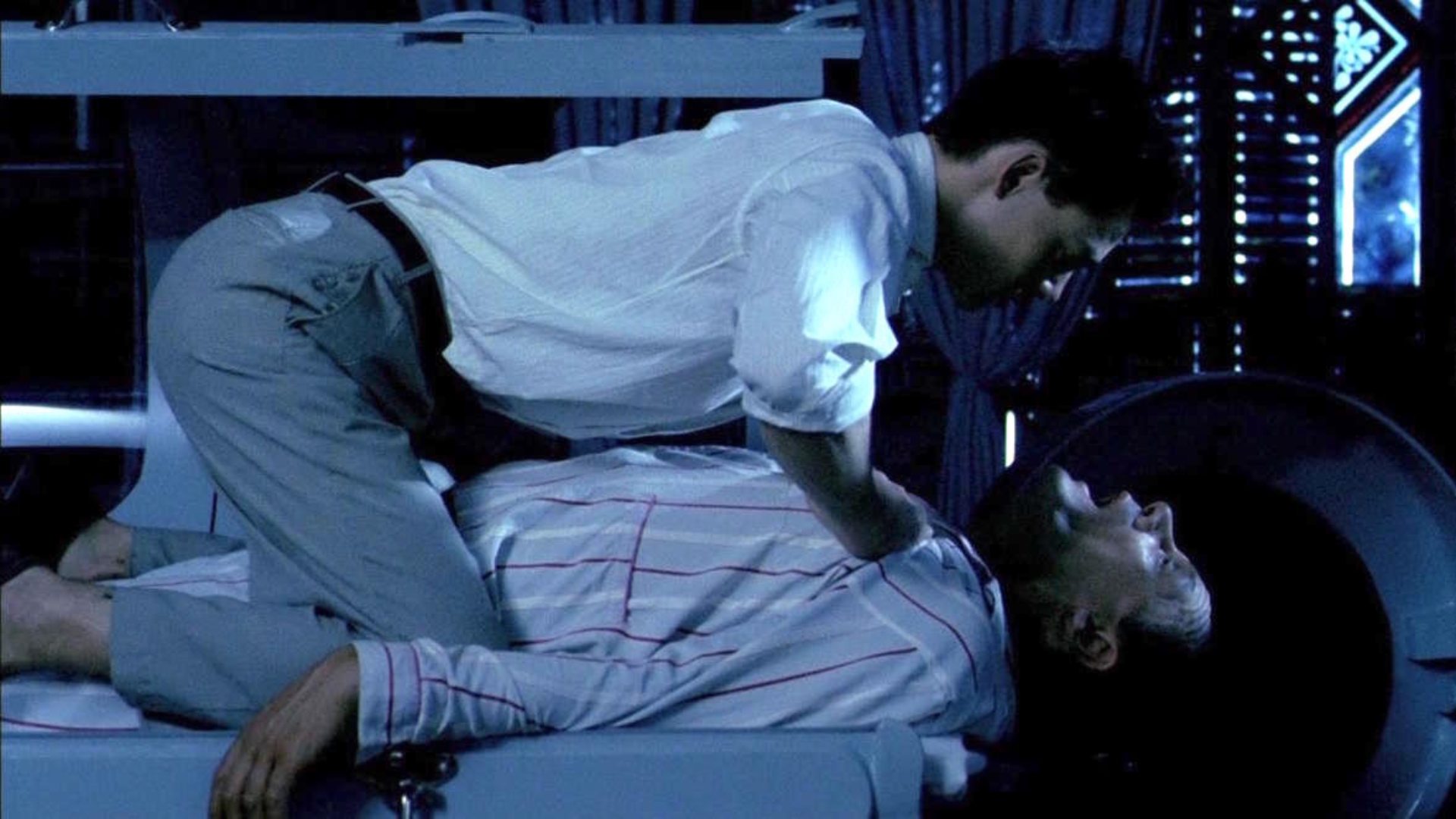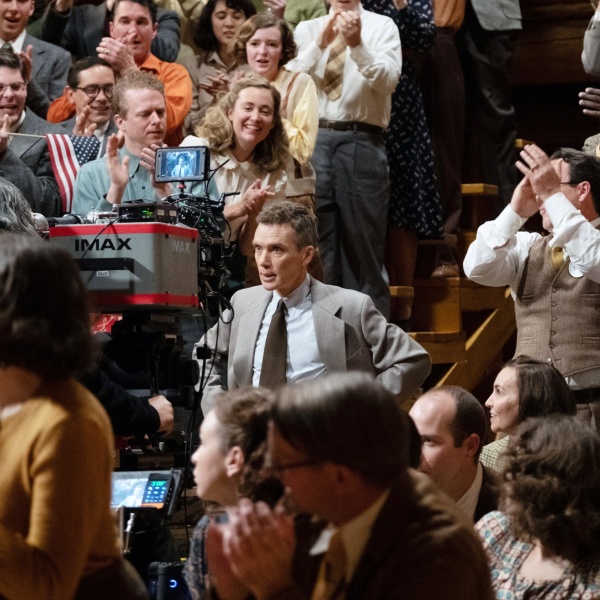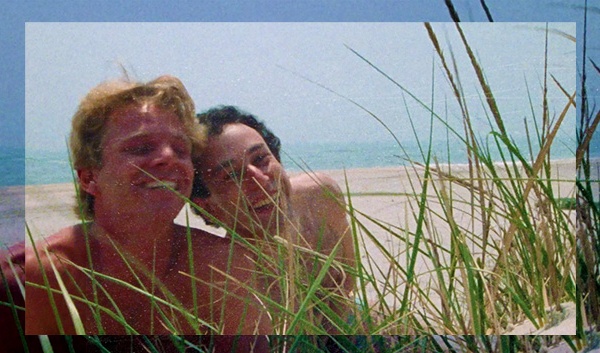
On Friday nights, IndieWire After Dark takes a feature-length beat to honor fringe cinema in the streaming age.
First, the spoiler-free pitch for one editor’s midnight movie pick — something weird and wonderful from any age of film that deserves our memorializing.
Then, the spoiler-filled aftermath as experienced by the unwitting editor attacked by this week’s recommendation.
The Pitch: Through a Glass Very, Very Darkly
If Arthur Slugworth haunted your dreams as a child, then prepare for Günter Meisner to paint your adult nightmares with a sickly blue palette in “In a Glass Cage.”
German actor Meisner played a certain beloved chocolatier’s cadaverous arch-rival in Mel Stuart’s inherently creepy “Willy Wonka & the Chocolate Factory” in 1971 — exactly 15 years before he’d play a sadomasochistic Nazi doctor in Agustí Villaronga’s post-World War II revenge picture, “In a Glass Cage,” from 1986. And here, Meisner is just as lacking in life on the outside as inward, in a cruel, psychosexual brain-fuck of a Holocaust movie that elegantly ripples the lines between sex and death, grindhouse and arthouse.
A high-minded horror movie about Nazi crimes transplanted to Spain as a death cry over the evils of another fascist dictator — Francisco Franco died 10 years before this film’s release — may seem an inept choice for a Pride Month-centric After Dark. But this warped and perverse thriller features a psychopathic twink antihero worthy of Pedro Almodóvar, and enough psychoanalytic fodder to fill years of sessions with the deepest Freudian head case.
Here’s a movie that’s haunted me since a Blu-ray release made “In a Glass Cage” available on American home video in 2011 for the first time. Villaronga’s feature debut stars Meisner as Klaus, a Mengele-esque pedophiliac doctor who, after exiling to Catalonia to keep torturing and raping children after the War, survives his own suicide attempt. One of his victims, Angelo (David Sust, said psychopathic twink), escapes Klaus’ lair of sadism with evidence of his crimes. Klaus flings himself, with a dead-in-the-eyes, hardly atoning resignation off a roof, only to live and end up in perhaps the worst possible punishment: surviving in an iron lung, left to be cared for by his long-suffering, chainsmoking wife Griselda (Marisa Paredes). And if we’re talking queer canon here, Griselda’s bleach-blond curls and oozing ennui cut a silhouette straight out of Rainer Werner Fassbinder’s most despairing heroines.
It’s her misery in their sprawling country house — a gloomy marvel of production design by Francesc Candini — that opens the dark door to a home invasion. Angelo has returned, older and possessed by a quiet rage. Soon, he becomes Klaus’ master caretaker, by day inveigling their small daughter into trusting him, and by night reenacting Klaus’ grisliest crimes while Klaus is forced to do nothing but watch behind glass amid the slow patter of the iron lung. These involve twilit self-abuse and readings from Klaus’ own diary entries detailing in explicit terms what he did to young boys while working as a Nazi.
But in a dark twist on the you-and-I-are-the-same of so many a staredown between a criminal and his destiny decider in cinema, Angelo begins to actually commit the very crimes Klaus did. Which means Villaronga puts up onscreen the ghastly horrors we’ve only so far heard recited as Angelo lures frightened children to the house and more.
That’s only the setup of a movie so aesthetically striking that its beauty becomes a historical reflex: to locate the sublime in the ugliest of people and places is the only way out of atrocity. And to turn the Holocaust into an arthouse horror movie was a brazen move on Villaronga’s part, one that would be deemed exploitative by the standards of now, especially with “The Zone of Interest” in the very recent rearview. The film’s style and moral ambiguity, despite its graphic content, won over critics at the time who would be no less than appalled today. From Angelo’s chicly all-black look as all hell breaks open to Jaume Peracaula’s funereal cinematography, the filmmaker is obviously in love with beautiful things that wither and die. It’s just that beauty, sometimes, can only be wrapped up in horror. —RL
The Aftermath: They Just Don’t Torture Nazis Like They Used To, Do They?
The most popular torture movies ever made arrived in theaters shortly after 9/11. Human rights violations involving the U.S. military were reported out of Abu Ghraib and put a spotlight on American war crimes just as hits like “Saw” and “Hostel” were storming the box office. Some horror aficionados argue that extreme gore emerged on the big screen as an answer to the disturbing details that were already making headlines across the globe. People in the west, theorists claim, were looking for catharsis outside of the news, and seeing a sadistic puppet pressure Cary Elwes into cutting off his own leg in a dirty bathroom was oddly comforting back then.
Watching 1986’s “In a Glass Cage,” however, there’s an uncomfortable sense that nearly all theatrical torture — no matter which cultural, generational, or artistic lens a director chooses to show it through — will always feel grimly Nazified at its core. Holocaust films have found new resonance with modern audiences against the sobering reality of current world conflicts, but as a matter of genre, the creative cruelty that ran through Germany during World War II has never left scary movies. From “reverse bear traps” to “human centipedes,” there’s an almost playful inventiveness to so-called torture porn that has seen scads of moviegoers willfully forget the time Hell earnestly set up shop on Earth all thanks to the Third Reich.
As my co-author alluded to in his brilliant After Dark pitch, “The Zone of Interest” saw writer/director Jonathan Glazer smartly sidestep dramatizing Nazi atrocities with a masterful portrait of a German family filmed on location at Auschwitz. The Best Picture nominee, which won Best International Film and Best Sound at the Oscars, relied heavily on audio to recall the enormous tragedy of a genocide that killed millions. Here, for “In a Glass Cage,” the late Villaronga makes painstaking work of visually depicting the medical tortures endured by some concentration camp victims that are typically deemed too awful for audiences. With its characters far removed from the real historic conflict in both time and place, this Spanish spin on a German nightmare achieves its authenticity not through a meticulous reenactment but with bold aesthetics and an evermore complex portrayal of dark emotion that is no doubt queer.
Jewel tones and chiaroscuro styling don’t seem like an obvious fit for a story that earnestly imagines a little boy having his heart injected with gasoline. And yet, as the stunning and cynical Angelo (psychopathic Twink indeed!), so defeated he can only find pleasure in pain, Sust dissolves into a kaleidoscopic portrait of ostentatious revenge. “The blue distended veins on his neck moved me,” the young man coos to Klaus of a recent murder; he’s wearing a stylish uniform of indifference but uses that feathery tone innate to betrayed admiration.
Ostensibly, it’s the inescapable cycle of trauma that spurs Angelo to kidnap and murder children in front of the Nazi who once molested him, but Klaus’ more opaque motivation for becoming the most inhuman kind of abuser is of equal interest to Villaronga. The medically vulnerable man’s fascination with Angelo — his eyes tracking every move his jailer makes with bewildered fastidiousness — seems to stem as much from his bone-deep fear of death as it does a fondness for imaginative tortures. We have a sense of what drove these men to become killers from the outset, but it’s their prolonged commitment to hyper-stylized destruction that suggests who they really are underneath. It’s tough to pin down, but surely there’s a coming out scene in here somewhere.
To represent the extreme feeling behind what’s ultimately a homoerotic tension unthinkably mutated, Villaronga’s otherworldly visual approach proves essential. The tragic scene with the singing boy conscious while getting his throat slit doesn’t really work unless his blood becomes that memorable deep-red waterfall, rapturously representing Angelo’s loss of innocence and an overflowing societal grief via a singular haunting exsanguination. Many of these moments are more gorgeous than gross and editor Raúl Román makes room enough for them to recommend the whole movie. When “In a Glass Cage” finally does dare to reveal the lethal punishment Klaus himself must endure under Angelo, the understated choice to have him asphyxiate after an oral rape is striking in a different sense.
Witnessing an abject monster helplessly gasp — unable to wipe even the blowjob spit from his freshly defiled chin — there’s a genuine beauty to Angelo’s hard-hearted vengeance. It was a slow psychological suffocating that robbed him of his humanity too. Although Villaronga allows us to witness this final revenge fantasy like a fever dream shared by two equally tormented men, the ballad of Angelo and Klaus is more universal than that. The intense calcification of post-war traumas could lead any survivor to pursue justice in their own self-made chamber of pressurized despair. And while it can be interesting to consider what those 2000s horror directors might have done to Klaus if equipped with an iron lung, “In a Glass Cage” finds its tortured timelessness not behind bars or ensnared in some over designed trap — but lightly suspended mid-air, hanging alongside that one last breath millions will never take. —AF
Those brave enough to join in can stream “In a Glass Cage” free on Tubi. IndieWire After Dark publishes midnight movie recommendations at 11:59 p.m. ET every Friday. Read more of our deranged suggestions…
- ‘Girltrash: All Night Long’: ‘D.E.B.S.’ Filmmaker’s Lesbian Soft Rock Musical Is a So-Bad-It’s-Good Banger
- Ready for ‘Pillion’? Watch Dudley Dursley Get Dommed by a Leather Daddy Right Now in ‘Please Baby Please’
- ‘Sliver’ Is Mandatory Midnight Movie Viewing for Any ‘Basic Instinct’ Fan







